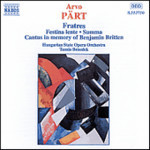
Fratres / Festina Lente / Summa
 $25.00
Out of Stock
$25.00
Out of Stock6+ weeks add to cart
ARVO PART
Fratres / Festina Lente / Summa
Hungarian State Opera Orchestra / Tamas Bendek
[ NAXOS / CD ]
Release Date: Saturday 19 January 2008
This item is currently out of stock. It may take 6 or more weeks to obtain from when you place your order as this is a specialist product.
Arvo Pärt was born in Paide (in central Estonia) on 11 September 1935. An only child, his parents divorced when he was three, and he was brought up by his mother (a kindergarten teacher) and stepfather.
With piano lessons from the age of eight (after the family had moved to a house in Rakvere in the north east of Estonia containing a concert grand), he received his rudimentary musical education at the Rakvere Children's Music School between 1946-1953. Finding that the repertoire of piano pieces he was given to play did not tax him fully enough he soon began writing his own short pieces, mainly for piano, although he also composed songs.
Studies continued in 1954 at Rakvere Secondary School and Tallinn Music School, where he studied composition and music theory. Whilst at Secondary School in Rakvere he was able to hear classical orchestral music from recordings transmitted over the public loudspeaker system in the town square, extending his somewhat limited musical horizons by cycling round and round the square on these occasions. His composition teachers at the Tallinn Music School were Harri Otsa (b.1926) and Veljo Tormis (b.1930), study that was interrupted by two years of compulsory military service during which he worked as a snare drummer in an army band. It was not until autumn 1957 that he was finally able to enrol as a postgraduate student at the Tallinn Conservatory.His composition teacher there was Heino Eller (1887-1970), who had himself studied composition at the St Petersburg Conservatory under Glazunov (whom Pärt acknowledges as his musical grandfather) and who played a central role in the development of Estonian music both as composer and teacher.
Pärts first works, two piano Sonatinas and a Partita, were neoclassical student pieces. Then in 1960 he became the first Estonian composer to espouse serialism (Nekrolog) and, using other avant-garde techniques including pointillism and aleatoricism, explored its potential in a number of experimental works Perpetuum Mobile (1963), Symphony No.1 (1964), Diagrams (1964), Musica Sillabica (1964), and Solfeggio (1964). In an attempt to extricate himself from what soon became a musical impasse, his next works adopted (and played with) baroque and classical forms and incorporated borrowed tonal gestures the brief Quintettino (1964), Collage on B-A-C-H (1964) and the cello concerto Pro et Contra (1966). With the composition of Credo (1968), the quintessential work of the early period and the first to set a religious text, Pärt finally reached the impasse that had been threatening, created by the fact that his own compositional voice had effectively been eclipsed by that of Bach.
Tracks:
Fratres for Strings and Percussion
Fratres for Violin, Strings and Percussion
Festina Lente for Strings and Harp Ad Libitum
Fratres for String Quartet
Fratres for Cello and Piano
Summa for Strings
Fratres for Wind Octet and Percussion (arr. B. Brinner)
Cantus in Memory of Benjamin Britten for Strings and Bell
